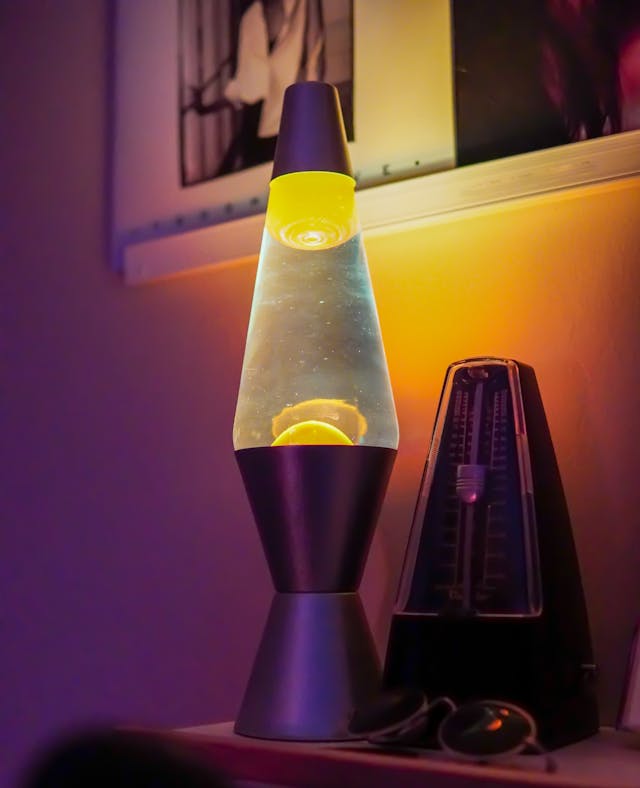
How does a lava lamp work? There are two principles at work in a lava lamp. The first is how a substance can stay together when surrounded by water. The second is how heat affects the density of a material.
The lava lamp that we know today was invented by a British accountant called Edward Craven Walker in 1963, but he was inspired by designs created by an inventor called Donald Dunnet. Dunnet had invented an egg timer that used a lot of the ideas that would end up being used in lava lamps. Walker was in a pub, and he saw Dunnet’s egg timer on a stove. Dunnet’s device used heat from the stove to make blobs of a liquid rise and fall. Walker loved the idea and had an idea to make it into a lamp. Donald Dunnet patented his idea, but died shortly afterwards, and his idea never reached the market. Walker spent about 13 years working on his lamp in his shed. He experimented with many different materials, containers, and light and heat sources before hitting on his winning combination. Then, with his wife, he formed a company called Crestworth Ltd. and started to produce his lamps under the name Astro Lamp in 1963. His timing was perfect, and the popularity of lava lamps grew in line with the emerging hippy culture.
So, how do they work? The first principle is that of immiscible liquids. “Immiscible” means that the two liquids do not mix. Lava lamps use two liquids. The main one is water, which is often chemically treated so that bacteria don’t grow, and it stays clear. The second liquid is usually paraffin wax, oils, and other chemicals. Paraffin wax and kerosene are both oils made of fat, and oil and water don’t mix. This is because water molecules are polar molecules, which means they are negatively charged at one end and positively charged at the other. The oxygen molecule in water has a slightly negative charge, and the hydrogen molecules have a positive charge. Because of this, the oxygen atom in one water molecule is strongly attracted to the hydrogen atoms in another water molecule, and they form a very strong bond. It takes a lot of energy to break these hydrogen bonds, which is why you have to heat water so much to turn it into steam. Oil is nonpolar, which means its charge is balanced. The charge in oil is not strong enough to break the hydrogen bonds in water, and the oil molecules stick to the oil molecules and the water molecules stick to the water molecules. This attraction keeps the two separate, and it means that if oil is submerged in water, it forms bubbles because the outer edge of the bubble is attracted to the oil and repelled by the water.
The second principle is that of density. Paraffin wax and oil are mixed until their density is very similar to that of water. That means they stay pretty much buoyant. They don’t sink and they don’t float. Paraffin wax on its own is less dense than water and would just rise to the top. The mixture in the lamp is just dense enough that if left alone, it will gradually accumulate at the bottom. When the lamp is turned on, a light bulb at the bottom of the lamp provides light, and it provides heat. The thermal energy from the bulb enters the wax and oil at the bottom of the lamp and it excites the molecules. When excited, the molecules move more and they spread out, lowering the density of the wax. The density is now lower than that of the water it is surrounded by, and the wax rises to the top of the lamp. As the wax gets higher, it gets further away from the heat source and loses thermal energy back to the water. The molecules in the wax move less, the density increases, and the wax starts to descend again. This is why the wax blobs move up and down, so long as the lamp is switched on.
The wax and oil in the lamp are often colored to give the light more of a psychedelic effect. There is also usually a small hidden metal coil at the bottom of the lamp that helps to heat the wax bubbles equally, so that they deform and mix with each other. This makes the bubbles more of a teardrop shape than they would be if there was no coil.
There is a similar principle at work in a Galileo thermometer. That is a water filled container that has lots of glass bubbles, each one with colored liquid and a temperature tag. The bubbles float in the water, and the bubble that floats the lowest is the current temperature. All of the bubbles are calibrated to be the same weight. The tags with the temperature on them are all slightly different weights. As the temperature of the room changes, the temperature of the water changes, and the density increases or decreases. This makes the differently weighted bubbles sink or float. And this is what I learned today.
Sources
https://en.wikipedia.org/wiki/Lava_lamp
https://en.wikipedia.org/wiki/Edward_Craven_Walker
http://www.imovatedesign.co.uk/astro/donalddunnet.html
https://kids.tpl.ca/wonders/how-do-lava-lamps-work
https://science.howstuffworks.com/innovation/science-questions/how-does-lava-lamp-work.htm
https://www.smithsonianmag.com/arts-culture/the-history-of-the-lava-lamp-21201966
https://www.science-sparks.com/why-dont-oil-and-water-mix
https://science.howstuffworks.com/how-does-a-galileo-thermometer-work.htm
